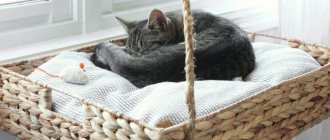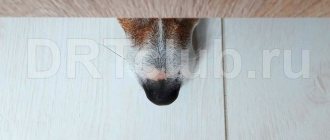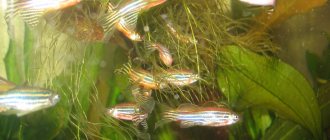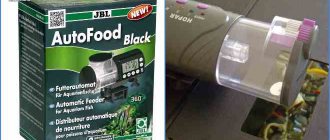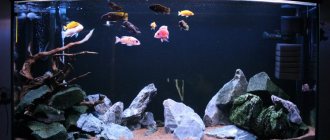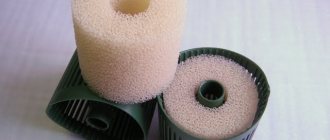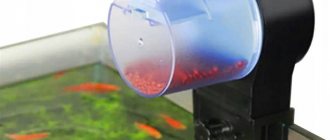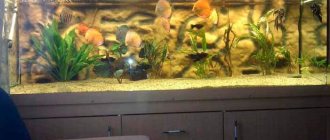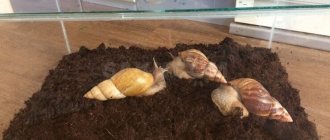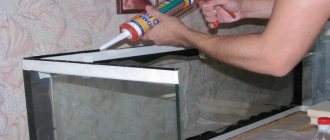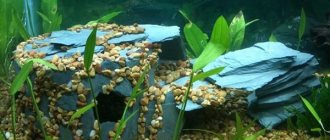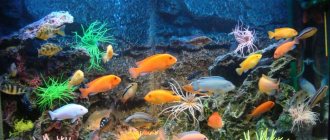If in your family, among friends or acquaintances there are older generation aquarists - those who kept fish back in Soviet times, the era of shortages - then you should have heard from them more than once how much easier life is for modern aquarium lovers.
Indeed, stores now offer a huge amount of equipment and medicines. The approach to maintaining aquariums has also changed: for example, there is no need to completely change the water in the aquarium every week. A huge assortment of aquarium fish, plants, and invertebrates allows you to create an ideal balance in your home pond.
But the most important thing is that there is a huge selection of ready-made fish food. Aquarists of the older generation had to spend a lot of time preparing food for their pets, getting bloodworms and daphnia, and getting scarce ready-made food.
However, their experience can also be useful for modern aquarium lovers, because food prepared with your own hands means confidence in the quality and naturalness of the ingredients, and, therefore, in its benefits for the fish.
What do fish eat in natural conditions?
Proper nutrition significantly affects the health of aquatic pets, therefore, with regular errors in nutrition, the fish can get sick and die. To reduce the likelihood of fish diseases due to improper diet, you will need to find out what aquatic inhabitants living in natural conditions eat.
Most river and lake inhabitants are omnivores, so they consume:
- decaying vegetation or fish;
- seaweed;
- insects and worms;
- arthropods;
- protozoa;
- other fish;
- chopped fruits and vegetables.
Among such an abundance of nutritious foods, it is not difficult to choose a diet for fish, but each individual has its own priority foods. Some pets prefer mostly plant food, while others prefer live food, so when choosing a diet for waterfowl, you need to start from this.
Many aquascapers argue regarding the question of whether it is better to underfeed or overfeed. And, despite the fact that overeating pets die from regular overfeeding, malnutrition is not considered beneficial; this greatly affects the juveniles and fry.
How to make your own food for aquarium fish
Part 1 food
Food - it just so happened that until recently I could not decide to switch my fish to natural food. I was afraid of complications, illnesses and other problems (water spoilage, for example). Therefore, I fed her with high-quality “drying”. Tetra tablets, food from “Living Water” and some more for variety. At the same time, I was constantly thinking about how it would be to start feeding my animals normal “live” food. Well, conditionally alive. For example, frozen bloodworms. I’m afraid to think about the tubifex even now, but I dared to give bloodworms a couple of times. Then I was very worried. screw piles My fish were very happy with the bloodworms and seemed to have overeaten. Try to calculate the “dose” for a large, motley group! And everyone really, really wants to eat. They grabbed as many as they could. Cherries, and they carried pieces through the bushes. For some reason I was scared then. My fish haven’t gotten sick until now, and there’s no need to continue,” I decided, and then the bloodworm feeding abruptly ended. I tried breeding nematodes. I bought the “culture” from the girl and diligently tinkered with it for some time. I realized that I wasn’t fanatical enough and “gave up.” As with ciliates, which at one time I bred for fry and filter feeders. This is a confusing matter and “not my way.” Although... who knows?
Part 2
So. What else have I tried? - Frozen daphnia. For some reason the fish were spitting. I threw it away and didn’t experiment anymore. I read all sorts of fish recipes on the Internet: well, beef heart with nettles, boiled chicken fillet, boiled frozen shrimp. Egg yolk (hard-boiled) and soaked oatmeal. In addition, there are a bunch of complex multi-component compositions, the preparation of which (in my opinion) requires truly heroic efforts. Whatever people feed their fish! But I definitely won’t mess with meat. — It’s scary, even creepy (forgive the water kettle-reinsurer, now I’m already laughing). It was there that I learned about the “fish omelette”. I got into it. It caught fire. I did it anyway. Even with its own fillings: oatmeal, paprika and dried parsley. I also added “Fishtamina” by Seravsky. Okay, it looks like it worked. Tasty. The fish swooped in, instantly swept away the offered portion and persistently begged for more. Additional information on making food The first experience inspired me, and I took the risk of preparing more food from mussels. This is generally light, but is eaten with great pleasure, as stated by the inventor of the recipe. Since then I feed him 2 times a week with mussels, 2 - 3 times with omelettes, and the remaining times - for now - with dry food. (Actually, I’m very proud of myself: I finally decided! Someday I’ll get to live bloodworms, cyclops and coretra, I promise.) The mussel food will last for a long time. Comfortable. They say it can be stored in the freezer for about 3 months. Well, I won't keep it for that long. If they don’t eat it, I’ll feed it to the dog and prepare a fresh portion. Here.
VIDEO TUTORIALS ON PREPARING HOMEMADE FOOD FOR FISH
Watch carefully how a specialist prepares a fish omelette: And now, let’s learn how to prepare a delicacy from mussels: Here is another recipe, for large predators (it is also possible for other types of fish, only the amount of “product” must be reduced so as not to be stored for too long)): In fact, there are many more recipes on the Internet. Look, try, improvise) As for mussels, shrimp (boiled-frozen) and sea fish, I finally realized that “we need to keep it simple”))) Take a piece of mussel, shrimp or fish (can be raw, can be boiled ) based on the size of the aquarium and the species and quantitative composition of the population. That is, I usually give at least 2 whole mussels 100-liter In a sparsely populated 5-liter bottle I let a small piece (about 5 mm) “float freely”. Smaller doesn't make sense. Let me explain: if you can safely leave food in a 100-liter container until the morning (they will eat every last crumb), then you need to remove the remains from a 5-liter container within a maximum of half an hour (otherwise I will spoil the water). It is especially important to remove food residues from an unfiltered and unblown “ aqua bank ”. My only addition is a warning: you should experiment with natural food carefully and only in a stable aquarium. Otherwise, an environmental disaster is possible ( click on the picture on the left ). Freshly prepared food crumbles less than frozen food. With my population composition, you can still “get involved” with freezing. And if there are few or no cleaners in the aquarium, it will be very difficult to select the dose and remove the excess, keep in mind!
Rules for feeding in an aquarium
To prevent fish from getting sick due to overfeeding or malnutrition, you need to strictly follow a few simple rules:
- If aquarium inhabitants are on the surface of the water soon after feeding, then you need to reduce the amount of food they eat.
- If the fish have a lethargic and thin appearance, this indicates a lack of food.
- You need to pay attention to the time the fish eat food. Normally, they absorb food in a maximum of 15 minutes (this is provided that they have a well-balanced diet).
It is also recommended to monitor the health of your pets. Among them may live less active, weakened individuals who do not have time to get food after other “vigorous” fish. They may regularly suffer from malnutrition and die as a result.
When feeding, you should monitor the process of eating food, first of all, pay attention to weak fish and try to feed them separately from the rest.
Nutrient foods should contain:
- carbohydrate and protein origin;
- vitamins;
- fats;
- micro- and macroelements.
Dry food for aquarium fish
To provide fish with such a complex of nutrients, you need to purchase special fish food in pet stores. It can be of many varieties: dry, live, frozen and should be given to the fish in equal proportions. Before you start feeding, you should read the instructions for use. However, in order to diversify the diet of waterfowl, it is recommended to make complementary foods yourself.
Plant food
These types of feeds can be prepared from vegetables, cereals, herbs, bread - there is also enough plant fiber there. This is an excellent food for herbivorous aquarium fish.
Feeding conditions are the same as for protein feeds: small portions, quick removal of uneaten residues.
- Semolina. Pour boiling water over a tablespoon of semolina and let steep for 15-20 minutes. Rinse, dispense little by little.
- White bread. Does not require special preparation. It is better to use stale, with a crust. Crumble and dispense a little at a time, discarding the remainder immediately.
- Lettuce, broccoli, carrots. Boil the vegetables, chop, rinse, and serve in small quantities.
- Cereals. Grind and brew with boiling water. Rinse the resulting mass.
Both plant and protein components can be mixed in different proportions, and vitamins can be added to them, based on the needs and characteristics of aquarium fish. You can develop your own, unique recipes for homemade food. It is recommended to add crushed dry nettle to the food (it contains a lot of vitamins, purchased in pharmacies), dried daphnia (gives the food an aroma attractive to fish, and can also act as an independent food).
Return to content
Making fish food with your own hands
Most often, residents of suburban villages make fish food with their own hands, because they do not have constant access to specialized stores. It is also needed by experienced aquascapers to diversify the diet of fish.
There are several recipes for making food at home.
Fish omelette
This recipe is very simple and can be prepared in a hurry.
Ingredients:
- egg;
- oil (for greasing the pan);
To prepare aquarium scrambled eggs, you need to crack the egg well in a glass and pour it into a hot frying pan, greased with oil. Fry for a few minutes until the mixture thickens. This recipe is practically no different from human nutrition, so it will not be difficult for any housewife to prepare it.
Before serving the omelet in the aquarium, it must be thoroughly crushed into crumbs, and when it gets inside to the fish, the scrambled egg must be completely eaten (to understand this, you should pay attention to the transparency of the water, it must be perfectly clean). If food particles remain, then you need to reduce the single dosage and store the product in the refrigerator for no more than 4 days.
Feed mixture
This type of complementary feeding is especially popular among aquascapers. This is due to the long shelf life, ease of preparation and randomly selected composition of nutritious products. Most often, aquarists prepare complementary foods from:
- lean fish;
- beef heart or liver;
- caviar of other fish;
- boiled egg;
- powdered milk;
- crackers;
- yeast;
- algae shoots;
- scalded shoots of plantain, nettle, dandelion;
- red (bell) pepper (enhances fishy color).
The aquarium owner can randomly select several products from this list or chop everything at once. To do this, you need to use a blender or meat grinder. You can also purchase special multivitamins and add them to the finished mixture according to the instructions for use.
This product can be stored in the freezer. Before freezing, you need to determine the dosage, distribute the complementary foods into molds (in the required quantity) and freeze.
It does not matter in what form the prepared mixture is given. Fish will consume it both frozen and thawed. The nutrient mixture can also be diluted with fresh, finely chopped herbs.
Also see how to prepare minced fish:
Protein feed
Prepared with your own hands from natural products, such food can become a complete replacement not only for dry food, but also for live food. In terms of nutritional value, they are not inferior to the highest quality aquarium food, but will cost you much less.
- Beef heart. Grate the frozen beef heart. Give, without rinsing, in small portions no more than once a day.
- Egg. Pour the raw chicken egg into a cup, stir, whisking lightly. Boil water and pour the prepared egg into the boiling water in a thin stream. Stir constantly while pouring. Catch the finished egg with a net. Feed the fish in small portions.
- Fresh frozen fish. The fish is grated or passed through a meat grinder. Having spread the prepared mass into small containers, it can be stored in the freezer for quite a long time. Before use, it is recommended to defrost the mass at room temperature and give it to the fish in small quantities.
- Boiled fish. The same method of preparation as fresh frozen, the only thing is that you can chop the food simply with a knife. In both cases, it is better to use white, lean fish, such as cod.
- Shrimp, krill. Boil, cool, chop, rinse.
- Milk. Boil the milk, cool, and remove the “foam”—a slimy film—from its surface. This will be the food. Give the crushed film in small portions.
- Curdled milk. Prepare yogurt (to do this, just let the milk sour). Important: curdled milk is prepared not from pasteurized milk, but from raw milk! Rinse the resulting mass to remove the whey. To do this, place it in a container with water, shake it, wait until the curdled milk sinks to the bottom, and drain the water. Repeat this several times. Washed curdled milk can be stored for quite a long time.
When feeding aquarium fish with home-made natural protein food, it is important to give the food in small portions and remove the leftover food from the aquarium immediately after feeding. These foods are very nutritious and quickly deteriorate; if left in the water, they will begin to decompose and can cause a bacteriological explosion - cloudiness of the water, diseases of the fish.
Protein foods are especially useful for predators, and boiled egg yolk is a classic food for fry or very young small fish.
Return to content
How to grow live food at home
Live food is the main food for fish. It contains a lot of protein products, so this food is irreplaceable.
The only drawback of feeding fish with live food is the possibility of becoming infected with harmful bacteria, so it is doubly important to grow such complementary food at home, despite the painstaking process.
How to grow daphnia
Daphnia for aquarium fish
To start growing daphnia, you will need to purchase a small aquarium (maximum 15 liters), a couple of elodea and some daphnia. This procedure should begin in the fall, and in mid-January this container should be placed in a well-lit, warm place and the resulting crustaceans should be fed with yeast.
Using this recipe, you can independently grow real, harmless live food every 3 months and completely supply your fish with it. After a large number of daphnia have formed in the container, most of them should be moved to another tank, and the remaining ones should be gradually fed to the fish.
How to grow homemade brine shrimp
Artemia for aquarium fish
Artemia naupliia is an indispensable product when breeding fry. It is endowed with a high level of natural adaptation and is the most nutritious zooplankton. To breed artemia you need:
- 20 gr. dissolve salts in a half-liter jar.
- Dried brine shrimp eggs – 0.5 tsp.
- Container with lid – 0.75 ml.
The vessel chosen by the aquascaper should have the same temperature for 1-2 days. If the temperature decreases or increases during this time period, it will cause the brine shrimp hatching to slow down or speed up, which is not very beneficial.
Breeding live food at home
The method, as a rule, is somewhat labor-intensive, but quite justified. It is difficult to argue with the benefits of live food for aquarium fish, and if you breed them at home, you can be sure that such food is safe for your fish. After all, this way the risk of introducing an infection into your home pond, which is always something to be wary of when purchasing live or frozen food, is practically reduced to zero.
Basic rules for growing various live food crops:
- Do not overdo it with the nutrient substrate. If fertilized too much, the crop begins to multiply rapidly, and then also rapidly die from lack of oxygen and poisoning by its own waste.
- Periodically change the water in containers where you breed live food.
- Do not keep the entire crop in one container, so that, in the event of the death of some part of it, you can easily renew the population from the reserve breeder.
Daphnia
Daphnia is an ideal live food for fry and most types of fish. In nature, in warm weather, it can be caught in small, sun-warmed reservoirs with stagnant water. In favorable conditions, daphnia will live with you in winter, and you can always provide your pets, especially young fish, with valuable, fresh, live food.
It is better to catch crustaceans intended for breeding in reservoirs where there are no fish - this way you do not risk introducing an infection. Place the caught daphnia in a previously prepared container with settled water. Crustaceans are very sensitive to the amount of oxygen, so an aerator is needed. The water surface must be large enough. They do not like overexposure; the ideal temperature for breeding is from 22 to 25 degrees. A fifth of the water should be changed daily.
For feeding, you can use yeast (a pinhead-sized amount is diluted in a spoonful of water and introduced into a dispenser container). Don't be afraid of cloudiness - it will pass quickly. You can also use water tinted with blood (from washing meat or fish) - add very little of it, no more than a tablespoon. Juice from cabbage, beets, and carrots is also suitable for food - a teaspoon per 5-6 liters. Make sure that the water does not spoil - it should not give off an unpleasant odor, because crustaceans filter the liquid by eating excess bacteria.
Daphnia is an excellent live food for all types of fish, especially for feeding fry in winter. It can also save you from “blooming” water in the aquarium - just release the crustaceans there for a couple of days, and they will clean everything efficiently.
Nematode worms
A common, easy-to-raise live food. They live in moist humus. In order to get worms for the initial live culture, you need to collect last year's wet leaves, separate the nematodes and place them in a bowl with a mixture of flour and milk. Place a twig or piece of wood in a bowl. After 3-5 days, multiplied worms will begin to gather on the piece of wood. They are collected with a brush and fed to the fish.
The culture lasts for about a month, then the nutrient substrate must be changed.
Drosophila flies
An initial culture is not required for their breeding - these insects appear as if on their own wherever there are rotting vegetables or fruits.
To breed them, you need to place any fruit puree mixed with oatmeal flakes and yeast in a closed breeder. The first flies will appear in a couple of days, and after 8-10 days there will be enough of them to feed your pets.
Vitamins
Be sure to introduce vitamins. Especially if the fish stocking density is high. Pastes made from plant materials are used as vitamin complexes:
- pondweed;
- duckweed;
- cabbage leaves;
- nettle;
- milky ripeness of corn;
- representatives of legumes - lupine, vetch.
Vitamin B12 (cyanocobalamin) is added. It is needed for proper protein metabolism, and, therefore, has a direct effect on the growth of living beings.
